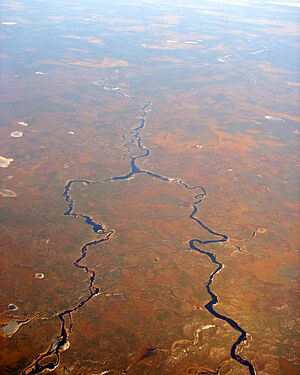Ogoki River facts for kids
The Ogoki River is a long river located in the Thunder Bay and Cochrane areas of Ontario, Canada. It's an important waterway that connects many lakes and other rivers.
Contents
The Ogoki River: A Journey Through Ontario
The Ogoki River starts from lakes west of Lake Nipigon. It then flows northeast until it reaches Ogoki. Here, it joins the Albany River. The Albany River eventually flows into James Bay, which is part of Hudson Bay. The Ogoki River is about 480 kilometres (300 mi) long. That's like driving from Toronto to Montreal!
A River's Big Change: The Diversion
In 1943, something big happened to the Ogoki River. A group called the Hydro-Electric Power Commission of Ontario, which is now known as Ontario Power Generation, changed the river's path. They built a dam and made a large part of the upper Ogoki River flow into Lake Nipigon instead. From Lake Nipigon, the water then travels into the Great Lakes.
This change was made to help create more electricity. The extra water flow was sent to a hydroelectric power plant at Niagara Falls. Hydroelectric plants use the power of moving water to spin turbines and make electricity. So, the Ogoki River helped power homes and businesses far away!
Fun on the River
The Ogoki River flows through a beautiful area called Wabakimi Provincial Park. This park is a great place for outdoor adventures. Many people enjoy canoeing along the river's calm waters. It's also a popular spot for fishing, where you can try to catch different kinds of fish.
North of Lake Nipigon, the Ogoki River forms a large area of water called the Ogoki Reservoir. This reservoir was created by a dam at Waboose Rapids. It stretches for about 70 kilometres (43 mi) and covers an area of around 150 square kilometres (58 sq mi).
A Historic Waterway
For a long time, the Ogoki River was part of an important canoe route. This route allowed people to travel all the way from Hudson Bay to Lake Superior. The journey would involve paddling down the Albany River, then the Ogoki River. After that, travelers would carry their canoes over land (a "portage") to the Ombabika River. From there, they would reach Lake Nipigon and finally Lake Superior. It was a vital pathway for trade and travel in the past.


